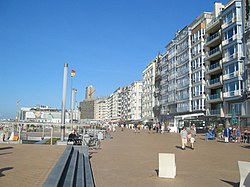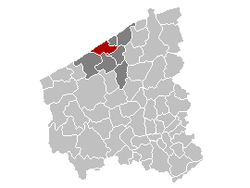Ostend
|
Ostend Oostende |
|||
|---|---|---|---|
| Municipality | |||

Promenade at Ostend seaside
|
|||
|
|||
| Location in Belgium | |||
|
Location of Ostend in West Flanders
|
|||
| Coordinates: 51°14′N 02°55′E / 51.233°N 2.917°ECoordinates: 51°14′N 02°55′E / 51.233°N 2.917°E | |||
| Country | Belgium | ||
| Community | Flemish Community | ||
| Region | Flemish Region | ||
| Province | West Flanders | ||
| Arrondissement | Ostend | ||
| Government | |||
| • Mayor | Johan Vande Lanotte (SP.A) | ||
| • Governing party/ies | SP.A, CD&V, VLD | ||
| Area | |||
| • Total | 37.72 km2 (14.56 sq mi) | ||
| Population (1 January 2016) | |||
| • Total | 70,600 | ||
| • Density | 1,900/km2 (4,800/sq mi) | ||
| Postal codes | 8400 | ||
| Area codes | 059 | ||
| Website | www.oostende.be | ||
Ostend (Dutch: Oostende [oːstˈɛndə]; French: Ostende [ɔstɑ̃d]; German: Ostende [ʔɔstˈʔɛndə]) is a Belgian coastal city and municipality, located in the province of West Flanders. It comprises the boroughs of Mariakerke, Raversijde, Stene and Zandvoorde, and the city of Ostend proper – the largest on the Belgian coast.
In earlier times, Ostend was a small village built on the east-end (oost-einde) of an island (originally called Testerep) between the North Sea and a beach lake. Although small, the village rose to the status of "town" around 1265 when the inhabitants were allowed to hold a market and to build a market hall.
The major source of income for the inhabitants was fishing. The North Sea coastline has always been rather unstable and in 1395 the inhabitants decided to build a new Ostend behind large dikes and further away from the always-threatening sea.
The strategic position on the North Sea coast had major advantages for Ostend as a harbour but also proved to be a source of trouble. The town was frequently taken, ravaged, ransacked and destroyed by conquering armies. The Dutch rebels, the Gueuzen, took control of the town. The Siege of Ostend, 1601 to 1604, of which it was said that "the Spanish assailed the unassailable and the Dutch defended the indefensible", cost a combined total of more than 80,000 dead or wounded, making it the single bloodiest battle of the Eighty Years' War. This shocking event set in motion negotiations that led to a truce several years later. When the truce broke down, it became a Dunkirker base.
...
Wikipedia




